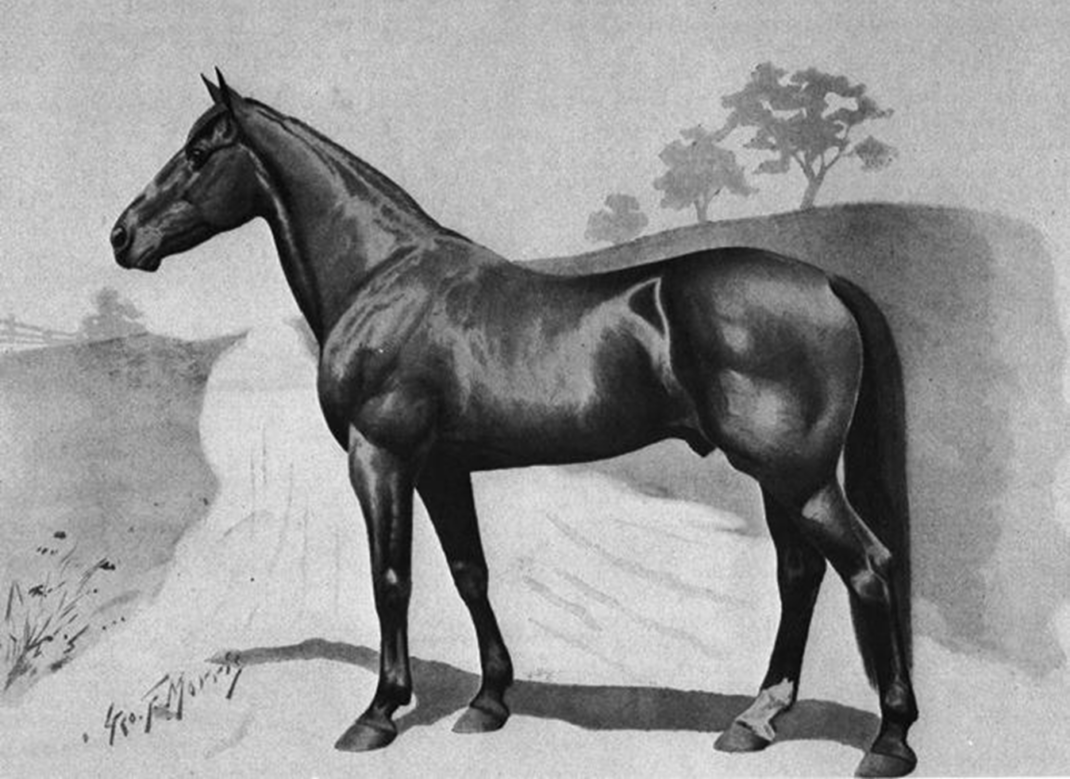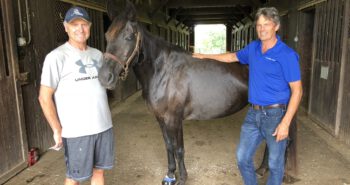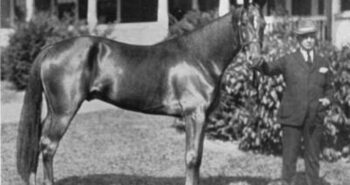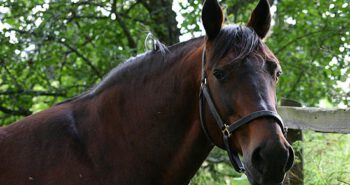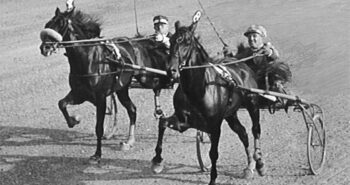It’s a story full improbable twists, cruel treatment and bizarre facts. What ended up as Hambletonian’s possibly greatest son at stud was in fact an alcoholic and named for the shadiest of writers who “reviewed” brothels in the name of journalism… It is said that cream always rises to the top. George Wilkes, the stallion who changed how trotters moved their hind legs and the paternal great-grandsire of Axworthy, started at the bottom but rose to the top.
As suggested by his diet of cow’s milk, Jamaica rum and sugar, the story of George Wilkes is a fascinating one. The story of the 1856 foal most likely starts 5 years prior, though. According to Ken McCarr, both in articles in The Harness Horse and his book The Kentucky Harness Horse, James Gilbert of Phelps, NY, noticed a mare being ridden by a cattleman on the road between Erie and Meadville, PA and after a little haggling bought the mare on the spot, saddle and bridle included, for $75. The mare, said to be roughly six year sold and whose name was Dolly, was a while later sold to circus owner William Delevan for $250 and he subsequently amended her name to Dolly Spanker. This had nothing to do with Spanker the thoroughbred – according to McCarr the name Dolly Spanker was a character in the stage play London Assurance, despite that character being male. Delevan then sold the mare to Harry Felter, a New York grocer and wine merchant.
Dolly Spanker never started in a race but Wallace stated in the Trotting Supplement, which was published in the first volume of the American Stud Book, that Dolly Spanker had trotted three miles in 2:27 (1.31,4) in 1853. 2.27, however, would equal the world record at the time – presumably he meant to say that she trotted each mile in 3:27 (2.08,7)? Dolly Spanker was described as pretty, below average in size, measuring approximately 15.2 hands (157 cms), stubborn, determined and far from easy to handle. After an incident which left Felter with a broken arm he sent the mare to his father, Colonel Theron Felter, in Newburgh, Orange County. He instructed his father to breed her to a good horse and then turn her out. The father bred the mare to William Rysdyk’s highly sought after six-year-old stallion Hambletonian, then standing for a fee of “only” $35 (it would go up later). The paternal pedigree was thus of the highest class but what about Dolly Spanker’s pedigree? When the foal started racing, nobody paid much attention to his maternal pedigree. The first claim was when Currier and Ives issued a colored picture of him and referred to his dam as “a Mambrino”, see below. This was not a bad guess, given that Mambrino, born 1824, hailed from Pennsylvania, but it was in the end just a guess with no factual basis.
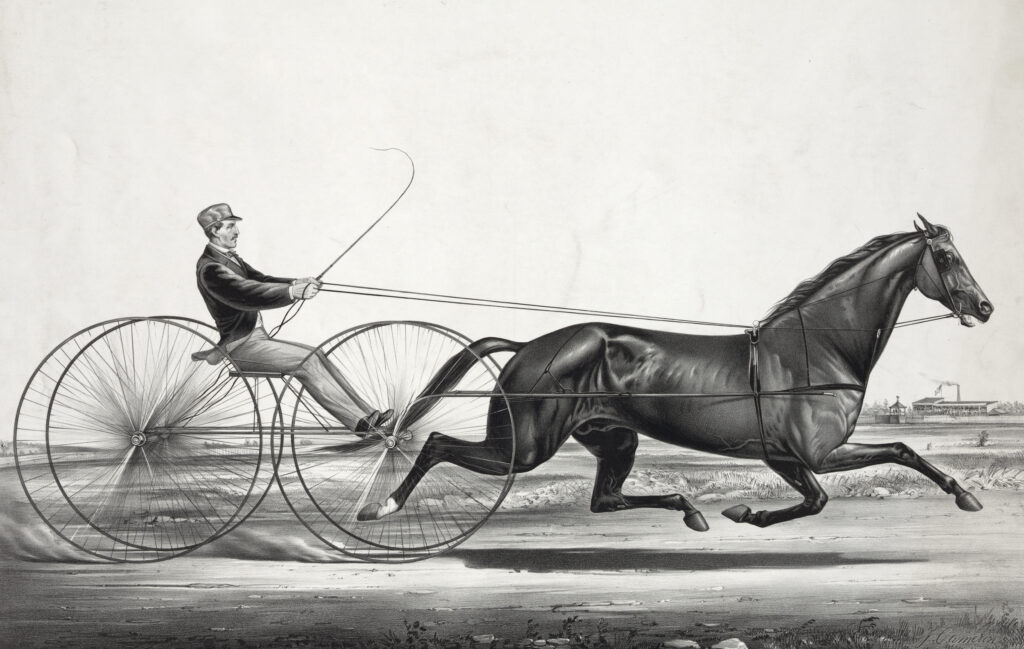
Who’s the daddy?
On December 1, 1877 John H Wallace met Harry Felter and William L Simmons in New York. Discussing the maternal pedigree of George Wilkes, Wallace reacted with surprise when both gentlemen told him they didn’t know, nor had they attempted to trace, Dolly Spanker’s pedigree. Felter stated he bought Dolly Spanker from Delevan and that Delevan in turn had bought her from Joseph S Lewis of Geneva, NY. Wallace then contacted Lewis and got the following response quoted in the book Racealong by WH Gocher:
“Some twenty-six years ago since I bought a brown mare from a gentleman by the name of James Gilbert, then living in the town of Phelps, in this county, for a friend and very soon after sold her to W. A. Delevan, of New York. She was then about five years old, a fine roadster, and could speed in about 3:30. He took her to New York, and after driving her some time sold her to my esteemed friend, Harry Felter. I think she passed into the hands of his father, and met with an accident. She was put to breeding, and had a colt by Rysdyk’s Hambletonian, that grew up to be the famous George Wilkes. For the benefit of many persons in New York I lost no time in looking about to learn the pedigree of the mare and of the horse that got her. On seeing Gilbert I learned that he got the mare of an old man who is now dead, by the name of Josiah Philips, of Bristol, in this county. I lost no time in sending a man, who lived with us at the time, by the name of John S. Dey, to Bristol, to get all the facts in the mare’s pedigree that he could get hold of. He learned through Philips that the sire of this mare was the Wadsworth’s Henry Clay, owned for many years by General Wadsworth, of Genesee. There is no mistake about this, as I have since learned from his neighbors that she was a Clay colt. Philips further stated that the dam of the mare was got by a horse called Highlander, a good horse, and owned in that section of country. I have no doubt about this, as there was such a horse in that section about that time. When I go to Buffalo, where Gilbert now lives, I may be able to get at more facts in regard to your inquiry, and if I can get hold of anything that will give more light on the subject before I am down in New York, I will drop into your office to see you.”
This might seem straightforward but Wallace couldn’t understand why Lewis had claimed that “for the benefit of many persons in New York I lost no time in looking about to learn the pedigree of the” when nobody in New York, including Felter and Delevan, had never heard of these findings. In his own words:
“The receipt of this letter, so straightforward and clean-cut in its statements, developed a mystery that was incomprehensible to me. Dates, names, places, circumstances, all stand out as evidences of the truth of the representations, and also as evidences that Mr Lewis had fully investigated the matter, and given the results of his investigations to his friends in this city; still, those friends had never heard the facts, or had entirely forgotten them. As there was a strong prejudice against Clay blood in certain quarters, it occurred to me that possibly that cross had been left in abeyance so long that it really had been forgotten. This did not clear up the mystery, however, and I determined to have the whole matter investigated from a different starting point. I submitted the matter to John P Ray, a very capable man, and he kindly and without reward undertook the investigation. The Philips family lived in the vicinity of Bristol, and the first of the family met by Mr. Ray was E. V. Philips, nephew and adopted son of Joshua Philips (not Josiah, as Mr Lewis had it), and he enumerated several head of Clays that had been owned by his uncle Joshua, among them a mare that was bred by Mr Clark Philips, bought of him when a yearling by EV Philips, sold as a four-year-old to his uncle Joshua, and by him the next year to “some man from the eastern part of the country.” He next met Clark Philips, who fully confirmed EV Philips about the Clay filly already referred to and said she was got when old Henry Clay was owned by Kent and Bailey of Bristol, and that her dam was “Old Telegraph” by Highlander, etc. In his original report to me of his investigation Mr Ray uses the following language :
“Now, as between the original and voluntary statement of Captain Lewis and the investigation carried through by Mr. Ray, there is no conflict and all is smooth sailing, and upon the information derived from these two sources the pedigree of George Wilkes was decided as established by the Board of Censors. But more recent discoveries made by Mr Ray, have raised a conflict that is irrepressible, for dates are involved and insisted upon that make the pedigree impossible. In his original statement Mr Ray says that Henry Clay made the season of 1846 at Bristol, “when he became the property of Kent & Bailey. He was kept in that town for some years.” Up to this point there is no contradiction. But in the past two or three years Mr Ray believes he has secured additional information, and this places Captain Lewis in a very unenviable position. The whole point of Clark Philips’ evidence is that he bred his mare “Old Telegraph” to Henry Clay when that horse was owned by Bailey Brothers, of Bristol, and I supposed they were the successors of Kent & Bailey of an earlier date. Now, as Mr Ray told us in his first investigation that Henry Clay passed into the hands of Kent & Bailey in 1847, and as he tells us later that he did not pass into their hands ’till nine or ten years after that date and then fails to fix the precise year, it must be conceded by all that his information is not wholly satisfactory. The best and final evidence is the service book of the horse. My best judgment of the whole matter is that Mr Ray’s later information is probably correct.”
This second report was accepted by the Board of Censors and the pedigree of Dolly Spanker was declared unknown. Looking at it historically, it seems evident that Wallace acted dishonestly. He writes in the above quote that there is a “strong prejudice against Clay blood in certain quarters”, conveniently leaving out that he is one of those most strongly prejudiced against the black stallion. In his book The Horse of America in his derivation, history and development, Wallace writing about Henry Clay that: “I have not been able to determine what rate of speed he was able to show. He certainly did not stand anywhere near the fastest, and he does not appear to have ever won a race, and perhaps never started in one.”
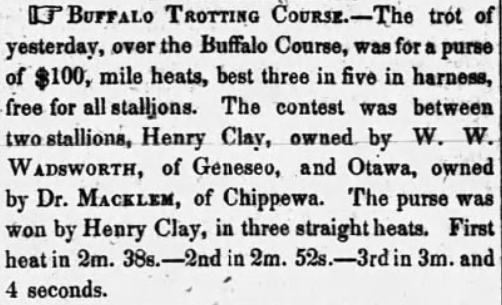
The problem is that Henry Clay won several races and this was published in newspapers at this time. Thus, Wallace either serves up an outright lie or is simply clueless to the facts. That latter can, however, is simply ridiculous and can be ignored: Wallace worked tirelessly over several decades studying and writing down information about trotters and pacers, their performances and their pedigrees. There is no way a person of Wallace’s stature would be unaware of Henry Clay’s wins at Buffalo in 1847 and 1848, for example, and for this reason it seems very safe to conclude that he simply lied because of his own prejudice against Henry Clay – and it would be just one of many such instances where Wallace let his personal opinions get in the way of sound judgment.
Wallace makes a point out of the uncertainty of who owned Henry Clay, and at what periods, but is historically well-known that Henry Clay was bought by General James Wadsworth in 1845 and that the latter was also listed as his owner in his 1848 race. This is also supported by the additional information secured by Mr Ray, but instead of using this as a corroborating statement given the publicly known information, Wallace frames it as a contradictory statement claiming that “this places Captain Lewis in a very unenviable position” The question is “how” – because in his letter, Captain Lewis did not make any claims as to where Henry Clay stood in 1847 or 1848.
In 1912 Dr JW Day, came forward in support of Dolly Spanker’s originally accepted pedigree, and backed it up with a lengthy letter from Stewart C Purdy, the nephew of Joseph S Lewis. For brevity the letter is omitted but it is published in its entirety in Racealong, pp 382 to 389, see link below. The information in the letter was never followed-up, nor was the claim even evaluated and Dolly Spanker remained without an officially accepted pedigree. There is no question, however, that Henry Clay should be considered the damsire of George Wilkes.
Getting hooked on rum
With or without a pedigree, in March 1856 Dolly Spanker was found dead in the pasture with her newborn foal standing beside her and in vain trying to wake her up. Nothing could be done for the mare and the little colt was hurried back to the farm. BK Beckwith, in the book Step and Go Together, tells quite the story of how the foal was raised. Beckwith’s account is not unique, though – other accounts, like those by McCarr, do not differ much from these, although they simply acknowledge the horse was given alcohol but don’t make a bit deal out of it. They limit that part of the story to merely factually including that rum was mixed in with his food – although in fairness it probably wasn’t ideal reading back then to include information suggesting one of the key founders of the breed was close to being a juvenile alcoholic.
“The foal was small and didn’t like drinking the cow milk he was offered. Colonel Felter suggested to the women that they spice up the milk with some rum and also a pinch of sugar. He coughed a little on the first chunks but the Felter women persisted and the foal eventually got it. The youngster was undersized but had inherited his mother’s willfulness – and growing up a spoilt young brat surely didn’t help matters. He wouldn’t accept his formula unless it contained rum and sugar. This continued when he moved on to hay and oats. One day the Colonel decided to stop giving the young horse his rum. The horse, then named Robert Fillingham, stopped eating and was said to just stare into the wall with a kind of dreamy look in his eyes. The family resisted as long as possible but the only way to get him to eat was to keep mixing in the beloved Jamaican rum in his food. He was broken in as a 3-year-old and it was said that, provided he got his daily sup of rum, he could beat every horse in Orange County. Regardless of what was said, with hindsight it is obvious to see that he was a born trotter with no end of natural ability. Despite being unstarted, his reputation soon reached the New York brothers WL and ZE Simmons. The former went to see the colt and brought along his trainer Horace Jones. After a trial the three-year-old changed hands for $4,000 and another horse – a hefty sum at the time, possibly the highest ever paid back then for an untested trotter. Simmons gave Jones an interest in the horse to train and race him. As was common at the time, young horses were not rushed and Robert Fillingham made his first official start at age 5 when he beat Bellfounder and Abdallah Chief in three straight heats at the Fashion Course in 2:33, 2:33 1/4 and 2:34 3/4 (1.35,1, 1.35,2 and 1.36,2).”
The trotting supremacy of the world
After his maiden win in 1861, Jones and the Simmons brothers set the bar as high as possible. His next start came roughly a year later, on September 10 1862, at the Fashion Course on Long Island. In a best-of-three-heats the 6-year-old Robert Fillingham would take on the 13-year-old Ethan Allen, though that was no age for an elite trotter back then, Ethan Allen. At 4, Ethan Allen had set a world record for that age when trotting in 2:36 (1.37) for Robert Fillingham-trainer Horace Jones. He had since trotted in 2:25 1/2 (1.30,4) in 1860 when defeating Princess, the dam of Happy Medium, at the Union Course racetrack. Most people initially only believed Robert Fillingham to stand little chance but his owners and their friends were very vocal in support of their trotter and it soon turned into one of the most anticipated races of that time. It wasn’t just a race between two horses. According to Ralph Moody, in his book American Horses, it “was for the trotting supremacy of the world between New York’s Hambletonians – almost pure Thoroughbred – and New England’s Morgans.” An article in the New York Times published the day after the race is so well-written and captured the events so well it is quoted almost in its entirety:
“Ethan Allen is by no means a horse without feet or bottom. He has done many a fast quarter, mile and three miles, and up to the conclusion of yesterday’s trial had hundreds of friends, whose plethoric piles of green-backs and shiners were always laid on him. In the popular mind he ranked, as indeed he deserved, with Patchin and Flora, and it required more than speed and the rumors of speed to detract from him, for the benefit of a stranger, his hard won position. The friends of the new horse have from the beginning been most confident of success. They had, in the first place, the most implicit faith in the astounding records of speed which were shown by his trainers and friends, they believed that he would at any rate, get down as low as 2:20 (1.27), and deemed it far from likely that Ethan would do better than 2:23 (1.28,9). (Note: the world record in 1862 stood at 2:19 3/4 (1.26,9) and belonged to Flora Temple)
Yesterday the trial was made, and the case decided. The day was perfect. The air was balmy, the sky unclouded, the dust unappreciable, general business dull, money plenty, and every thing as it should be to insure a pleasant day at the course. In the city, among sporting men, betting ran high. Robert’s friends offered $100 to $75, $100 to $50, and even $100 to $40 on the race, and were so confident not only of eventual success but of certain speed, that they offered $100 to $80 on two minutes and twenty-one seconds. Naturally such tremendous odds produced different mental effects upon various individuals. Some who knew of Ethan’s early fame eagerly grasped the proffered hand, covered the pile, and secured the bet. Others, however, were suspicious, deeming it a remarkably strange feature in the case, that an unknown horse could command such backing, with due regard to the ordinary chances of a race properly conducted. These latter declined betting, and as the result proved thereby showed their wisdom.
It would seem as if every hack in the City, every convenient vehicle in the livery stables, every spare stage-coach on the Island, and every obtainable fancy wagon in the county had been hired, chartered or obtained for the occasion. The various ferries were besieged by long trains of humanity-laden conveyances, and although extra boats were put on, hours were occupied in taking them to Hunter’s Point. The extra trains which were run by the Railway Company were absolutely crowded with people of all sorts and conditions, and the long and dusty road was processioned by cloud-enwrapped wagons, barouches and buggies, hurrying to the race.
At the Course there was gathered an immense crowd, variously estimated at from seven to ten thousand persons. The gay and festive wit-livers, who generously offered their little three-card-monte boards to the confiding public, were not permitted inside the gates, but just outside the barriers they congregated in swarms, and reaped harvests of silver, gold, and postage stamps, from the innocent mortals who watched “that spot,” and who, entering boldly upon the game, lost time and time again, and could not be satisfied until their cash was all gone, and it was time to go home.
The inclosure within the track, the beautiful mile bound park, was not dotted but filled with carriages and other vehicles, in many of which were the fairest of the fair and the gayest of the gay, dispensing smiles, champagne and sandwiches to their friends of longer or shorter acquaintance, and others again were occupied by men of prominence in various walks of life, whose names and checks are honored in our moneyed institutions.
The ladies’ stand – the start was from the old stand – was also filled, and the ‘Crocheron Mansion,’ where the accustomed hospitality of Mrs Crocheron was exhibited by herself and her gracious friends, was filled to overflowing, even to the crowding of the top of the porch by a host of bright-eyed and elegantly-attired ladies, whose unwonted presence added an unusual charm to the gathering, and lent a most desirable element of popularity to the cheerful proceedings of the day.
The horses were brought up at 4 1/2 o’clock, and were shown in front of the old stand, which, from bottom to top, not only, but all over the top besides, was crowded to literal discomfort with a most excited crowd. The betting was renewed upon the appearance of the horses, and the same tremendous odds which were so freely offered in the City were repeated on the track. The Hambletonian stallion Fillingham, owned by ZH Simmons, of the Delaware Lottery, was driven by the veteran Horace Jones, and the Morgan stallion Allen was driven by Dan Mace, whose lungular capacity is unequaled by that of any man on the face of the mundane sphere.
Each horse looked well, and despite the talk about Ethan Allen bring out of order, he was among the outsiders decidedly the favorite, and his fine showing led many of the believing public to venture their little all upon his success, and to take the great odds offered by his adversary.
The race was started at about five o’clock. Ethan won the pole, and after the usual preliminary filing the horses prepared to start. On the third start Allen broke badly; at the fourth he did the same but at the fifth they got the word, and went off fairly together. They kept well on till they reached the turn, when Mace, with one of his unearthly yells, plied the lash to Ethan, and brushing by Fillingham scraped his wheel over the latter’s nose, causing him to hold up, break, and lose ground. With Fillingham two lengths behind him, Ethan made the first quarter in 35 seconds, amidst the shoutings and screamings of his backers, who, in common with hundreds of others, rushed upon the track, hurrahing and screaming as if they had discovered some costly treasure. In the meantime the horses went on at a fair gait, pursuing the same relative position, until Allen broke and allowed Fillingham to almost close the gap between them, in which, however, he did not succeed, before Ethan made the half-mile in 1 minute 10 seconds.
From this point on the heat was exciting in the extreme. Fillingham steadily overhauled Ethan, and, while making the third quarter, passed him beautifully at a very speedy gait. The uncontrollable multitude, wild with excitement, crowded all over the track, and it was with the greatest exertion only that the Sheriffs were able to clear them off while the horses came down the home stretch.
After they passed the third quarter pole, Fillingham in the van, they were for awhile neck and neck, presenting a most beautiful sight, and tingling the blood in the veins of every spectator, and particularly that of every man whose hundreds depended on the result. A lucky brush of Fillingham’s decided the heat, as just before they reached the score he got ahead of Ethan, and won the heat in 2 minutes 24 3/4 seconds (1.30,0).
It would be useless to describe the ensuing scenes. Every passion that the human heart is possessed of – every shape that the human face can by any possibility assume when its owner sees fit to yell like a cross between a Sioux and a Chimpanzee – every diabolical profanity that the tongue of irreverent man can invent – these all were witnessed and heard by the unruffled reporter, whose pocket was in no way affected by the result, and who sat observingly by.
“Foul play,” “All made up,” “Superb,” “Isn’t he the boy?” “How are you Ethan?” “I’ll bet $1,000 to $300 on Fillingham.” These and other kindred remarks were made in loud and lively tones by the excited people, who crowded about the stand, and who, in several instances, proved their devotion to their beliefs, by a liberal shower of claret drops, drawn from their nasal prominence by the horny fist of an indignant opponent.
Before the second heat was called the betting assumed proportions most enormous, and at odds without modern parallel. We heard repeated offers of odds which no sane man would give unless he had a “dead open-and-shut” arrangement, by which he could with certainty play “head you lose, tails I win.” Both horses were tired when they came up to score, but of the two Robert seemed the worse off. At the first attempt to start it was evident that each was playing for wind, and that neither was in a hurry to get off.
At the second attempt they got a good send off, and took the word when side by side squarely and fairly. Ethan, as before, took the lead at the first turn and kept it until he broke, at which Robert woke up a little, but breaking in his turn, allowed Ethan to make the quarter in the advance, in 35 seconds. Fillingham being about a length and a half in the rear. From the quarter to the half nothing of interest occurred, until when within four lengths of the pole Ethan broke badly, when Robert caught him, lapped him, and side by side, with Robert just enough ahead to say so, they made the half in 1 minute 10 seconds, being a falling off from the previous heat.
Robert here brushed swiftly by Ethan, and led him handsomely to the third quarter. Mace whipped and velled, and shouted and screamed: Ethan broke, and broke so badly, that a distance seemed not impossible. However, he got him down, and they went beautifully to the score, Fillingham winning the second heat in 2 minutes 25 3/4 seconds (1.30,6), by the Judge’s record, although two of the best private watches made it but 25. Betting now ceased. Ethan’s friends looked glum. Robert’s friends wore cheerful countenances, and with gracious smiles invited everybody to drink, while the ladies, who, from the outstart, had favored Fillingham, waved gracefully their snowy handkerchiefs, and smiled beamingly on Horace as he approached then porch for feminine recognition and encouragement.
The third heat was a repetition of the others. After a good send-off, Ethan took the lead, made the quarter in 36 seconds, broke, lost ground, and allowed Robert to pass him. The latter worked well, and with apparent ease, making the half mile in 1 minute 14 seconds, and keeping the lead all the way home, which he reached in 2 minutes 31 seconds (1.33,8). Thus ended the great trot of the season. Thus was demolished the fame of Ethan and established the fame of Robert. At least 8,000 people saw it done, and of those some lost, in the aggregate, about $50,000, while others won the same, thereby making it, so far as the crowd is concerned, an even thing. The pickpockets did a good business, and so did the outsiders.”
The author killed Ethan’s reputation a bit pre-maturely: on June 21 1867, age 18, hitched to a running mate he defeated Dexter in 2:15, 2:16 and 2:19 (1.23,9, 1.24,5 and 1.26,4) over the Fashion Course.
As was alluded to in the above-quoted article, prior to the race the jungle telegraph was going crazy. Furthermore, Horace Jones “it was said, had developed wonderful speed in Robert, and a report was current that he had made his little mile in 2 min. 18 sec. (1.25,8), all of which was very far from being believed, though it went far toward making public sentiment.” If Robert Fillingham had trotted a mile in 2:18 (1.25,8) it would have been a world record: at the end of 1859 Flora Temple had lowered it to 2:19 3/4 in Kalamazoo, MI and it wasn’t beaten until Dexter and Budd Doble reduced it to 2:19 (1.26,4) on Jul 30, 1867 (he would lower it to 2:17 1/4 (1.25,3) later that year).
Current thinking is, quite naturally, that faster is better when it comes to records, but back in the 1800s it wasn’t quite so simple. The horse’s record determined it’s eligibility and had he set a 2:18 record he would naturally have been ineligible for the 2:24 trots and would have to forever settle for individual match races. In later years Simmons stated that, without any public present, Jones had driven Robert Fillingham in 2:19 1/4 and 2:18 1/4 (1.26,6 and 1.25,9) at Centreville not long after the match with Ethan Ellen in 1862. (The most famous of these moonlight trials was probably when Dan Mace drove Lady Thorn, with a record of 2:18 1/4 (1.25,9), to an alleged 2:09 3/4 (1.20,6) clocking in 1870 – it would take 14 years before Maud S did that same thing in an official race.)
AL “Gus” Wilson, later a leading Grand Circuit driver, who had taken care of Robert Fillingham for Jones, supported Simmons’ claims and pointed out that Robert Fillingham was a horse of exceptional speed who was capable of a quarter in 29 seconds. But, as stated above, he was never allowed to display his real powers in public.
Honoring a friend
Sometime at the end of 1864, or in the beginning of 1865, the owners decided to change the colt’s name to George Wilkes, in honor of a supposedly distinguished journalist friend of Simmons. The real-life George Wilkes was among the first to advocate building a railroad to the Pacific coast and was also decorated by the Czar of Russia for suggesting the trans-Siberia railroad. He is known in harness horse circles primarily for owning and editing the popular Spirit of the Times, which focused on harness racing, but there is much more to Wilkes, however – as was sarcastically made clear by use of the term “supposedly distinguished” above. Wilkes was born 1817 in the state of New York and, according to Patricia Cline Cohen’s book Flash Press – Sporting Male Weeklies in the 1840s, first gained some attention when he was arrested at 19 after “he and some other rowdy lads burst into a brothel and made mischief” – whatever that mean.
George Wilkes gained notority as one of three editors and proprietors of the Sunday Flash, a notorious and short-lived “newspaper” which, in the word of Cohen, “aimed to entertain and enlighten literate sporting men about leisure-time activities and erotic entertainments available in New York. Distinguished by a trenchant, mocking humor and a titillating brew of gossip about prostitutes, theatrical denizens, and sports contests, the papers offered guidance to men young and old intent on navigating the new world of unrestricted pleasure and commercialized leisure in the city. They frequently defended such behaviors in the vernacular of republicanism and democracy.” Though not directly pornographic or sexually explicit, it was certainly borderline at times. While edited by Wilkes, the Flash rated New York’s brothels and published descriptions and reviews of them. The newspaper also ran a series called “Lives of the Nymphs“, which with modern eyes is nothing but slut-shaming in newspaper form.
Wilkes’ former friend Mike Walsh provided the following character assassination of the man in a 1845 article in the the newspaper Subterranean: “He was formerly brothel chronicler for a beastly, fraudulent and disgusting obscene paper which was suppressed by the authorities as a “public nuisance,” called the Sunday Flash — has been a common loafer in groggeries and brothels, and actually spit in the face of a decent hard-working woman in the public street, who was defrauded out of some money either by him or the person who fed him. I have administered several kickings to the white-livered wretch for his conduct towards others, and I understand that he is now trying to commence blackmail again.”
A short career overview
Anyway, to return to the four-legged legendin question, the horse was renamed George Wilkes. It is not the intention to go through every start made so a shorter description of his career follows: he raced until 1872, when he was 16 years old. He started in 69 races, won 27 and was second 26 and according to most sources his earned slightly more than $20,000. SW Parlin, in his book The American Trotter – A Treatise On His History, Origin and Development from 1905, specifies his career earnings to $50,150, however. His personal best is 2:22 (1.28,3), set in Providence at age 12, and was a stallion world record. Despite the fantastic start to his career, George Wilkes had a long and hard career. In his later years he was often raced against faster, presumably better, horses. He was given to Hiram Woodruff for a few races in 1863 and Horace Jones, who trained him early in his career, died in 1864 by drowning while out in a boat duck shooting. He was then moved to Dan Pfifer and not too long after to Sam McLaughlin before John Crooks took over and drove him through the autumn of 1865 and the next two seasons. William H Borst then took over for the remainder of George Wilkes’ career.
One thing all historical accounts agree on was that George Wilkes was mismanaged and mistreated in his racing career. There is a consensus that he was whipped, often rather brutally, in the races and being a horse of high temper he clearly resented this. He would often quit trying and gained a reputation as a sulker and quitter. Parlin notes in his book that “it is evident that he was one of the most honest trotters that lived in his day, and at times suffered from cruel abuse. A man whom we have known for years, and whose word can be relied upon, says that a wire was braided into the lash of the whip with which George Wilkes was driven in his races, and he saw the whip applied so severely that the blood trickled down upon his legs after the heat was finished, and yet the horse did not break from a trot.”
The unique hind gait
George Wilkes was unique in more ways than one, though. From a description in the Spirit of the Times in 1862 (from early in his career, prior to his race with Ethan Allen a little later that year), “he is about 15.1 hands (155 cms), but all horse…. His traveling gear is just what it should be – muscular shoulders long strong arms, flat legs, splendid quarters, great length from hip to hock, and very fine back sinews. He stand higher behind than he does forward, a formation we like…. He is very wide between the jaws…. His coat is fine and glows like the rich dark tints of polished rosewood…. His temper is kind. We had the pleasure of seeing him at his work, and unless we are greatly mistaken he will make an amazingly good one. He has a long and easy way of going, striking well out behind and tucking his haunches well under him.”
This description does not describe his gait too well, though. George Wilkes’ gait was what made the horse truly unique and way ahead of his time. He had no excessive knee-lifting and the front feet movements were ordinary, but the hind legs was a different story. Charles J Foster wrote that “George Wilkes’ hind leg when straightened out in action, as he went at his best speed, reminded him of that of a duck swimming.” Another horseman claimed that when trotting he could reach his hind leg further back of the sulky, and hold it there longer than any other trotter he ever saw. With Hambletonian the trotters got longer legs and a more muscular rear engine, especially compared to the Morgan horses, like Ethan Allen, who had shorter legs. George Wilkes seems to have been the first horse which introduced a more powerful hind stride and also a wider hind gait, allowing for faster, cleaner passing-gaited trotters. (Although many of his get were also pacers.)
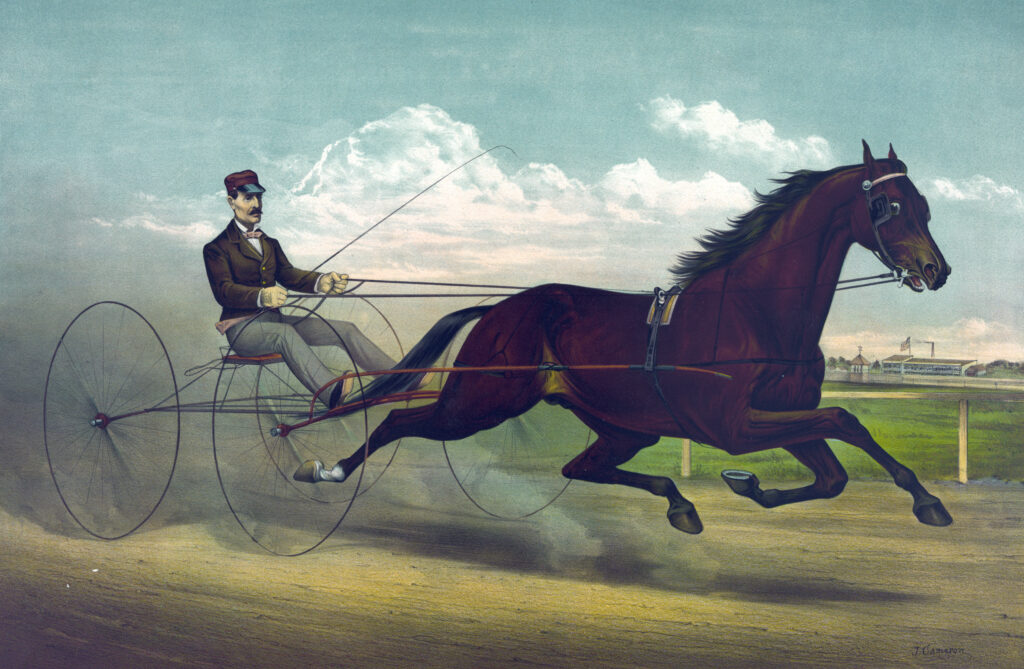
A cool reception
Despite him being a world champion there was limited interest from breeders in the East. He bred some mares every year, but since he was small and had a “ducklike” hind gait, Eastern breeders curbed their enthusiasm. Though some sources claim that he was widely used during his racing career, this is not supported by the number of foals – he only had between 400-450 lifetime foals – especially since he never had fertility problems. George Wilkes sired the Long Island-born mare May Bird 2:21 (1.27,6) but there weren’t that many foals by him in the East and no demand. However, in 1873 came the opportunity that would give George Wilkes a chance to write his name into harness history for good.
WH Wilson was a native of Illinois who lived in New York and had married a Kentucky woman. He noticed how the Bluegrass state had become the hotbed of thoroughbred breeding and expected the bloodlines there to be able to produce excellent harness horses, too. He was a good friend of the Simmons brothers and he finally succeeding in leasing George Wilkes for the 1873 breeding season. In the spring of 1873 he took the horse to Lexington where he had leased Ash Grove Farm – essentially the same farm later became the famous thoroughbred nursery Idle Hour Farm in the hands of ER Bradley – but it was a gamble as Wilson only had a one-year lease on the stallion.
Initially Kentucky breeders showed the same enthusiasm as Eastern breeders. At first there were derogatory comments were made about “Simmons’ baked-up pony”, but Wilson’s salesmanship won the day. Although the official stud fee was $100 he gave discounts for multiple mares, had mares bred on shares and even leased attractive broodmares. As a result George Wilkes covered 82 mares in his first season at stud in Kentucky. Paradoxically, George Wilkes’ popularity backfired on Wilson. When he realized he owned one of the most popular – and profitable – trotting stallions (this was before the concept of “standardbred” was formulated), WL Simmons refused to let Wilson renew the lease. Instead he moved to Kentucky himself and took back the management of George Wilkes. His first move was buying the Ash Grove farm, thus making George Wilkes’ home a permanent one. Simmons then set about gathering broodmares for his stallion. Any remaining skepticism toward George Wilkes disappeared as early as 1875. When the yearlings were broken a large number showed speed, early talent and a natural gait. Demand for his stud services increased and Simmons quickly acquired sons of George to also stand stud at Ash Grove. George Wilkes died on May 28, 1882, 26 years old, from pneumonia but his influence was just starting to show – and with time would grow massive.
A massive legacy
The legendary Dan Patch was bred 3×4 on George Wilkes and George was paternal grandfather to his sire Joe Patchen, himself an excellent pacer who several times got the better of Star Pointer, the world’s first 2:00 horse. World champion trotter Peter Manning’s dam is 4×3 on George Wilkes, as was the spectacular Hamburg Belle. Single G also hails from George Wilkes on the sireline through his son Onward and then Anderson Wilkes. Bingen’s dam Young Miss is 2×3 on George Wilkes. His damsire Guy Wilkes was one of California’s best sires and sired 75 horses (mostly trotters) under 2:30. McKinney, an excellent racehorse and sire, is a son of Alcyone (born 1877), a son of George Wilkes. McKinney’s sireline is still alive and well in Europe, primarily through Orlando Vici in France.
Through William L he is also the paternal grandsire of world champion Axtell. Axtell is in turn sire of Axworthy whose influence is massive. His most influential son, Guy Axworthy, is 4×3 on George Wilkes. The first 5 winners of the Kentucky Futurity all hailed from George Wilkes’ sireline – paradoxically the first horse to break the pattern was Peter the Great – who would later cross so well with Axworthy.
Simmons later expressed regret he had changed the horse’s name from Robert Fillingham. In later years the human George Wilkes turned against his friends, including Simmons who had named a trotting champion in his honor. George Wilkes the horse, though, surely deserves immortal status in harness history.
George Wilkes
(ex Robert Fillingham)
Bay colt born in Orange County, NY in 1856. Died in Lexington, KY on May 28, 1882.
Hambletonian 10 – Dolly Spanker (Henry Clay)
69 races: 27-26-0 – 2:22 (1.28,3)
Breeder: Harry Felter
Owners: Theron Felter – WL and ZE Simmons
Trainers: Horace Jones, Hiram Woodruff, Dan Pfifer, Sam McLaughlin, John Crooks and William H Borst
Drivers: Horace Jones, Hiram Woodruff, Dan Pfifer, Sam McLaughlin, John Crooks and William H Borst
Grooms: AL “Gus” Wilson and others

